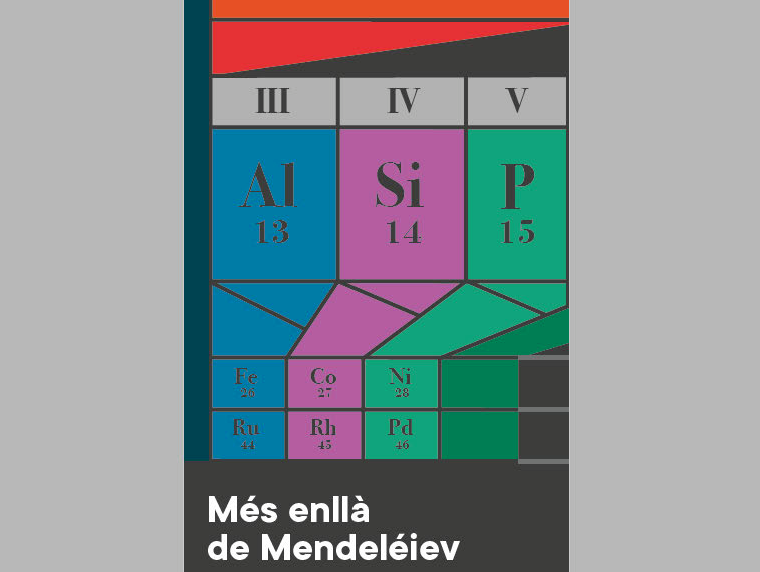
BEYOND MENDELEEV: 200 years of chemical classifications
Official opening on 27th of February.
Organised by: Faculty of Chemistry and Inter-university Institute López Piñero
Curators: Luis Moreno and José Ramón Bertomeu.
Periodic table of chemical elements is one of the fundamental components of contemporary science. Just like other aspects of science, periodic table presents a great variety of meanings that can be analysed from a historical perspective. It is commonly considered a classification which, in its graphical representations, is used as a didactic tool in classrooms. It is also often defined as a law helping to predict the properties of new elements. This method was used to provide evidence to the discoveries of the late 19th and early 20th centuries despite many exceptions, false predictions, and controversial experiments, which is still the case with the elements 119 and 120 if their existence is confirmed. On the other hand, outside the scientific community, the periodic table is one of the most popular images associated with chemistry. Thanks to the extension of secondary education, a great part of the population has become aware of some of the graphical versions of the table that can be found in science museums and general literature. The periodic table plays an important role both in the collective memory of chemistry and in its public image. These characteristics surely create a wide range of opportunities to use the history of its creation for educational purposes. Yet, they also give the possibility to spread pseudohistorical statements based on myths of scientific discoveries that leave behind certain spaces and figures in the history of science.
The exhibition resulted from one of these didactic proposals developed during the International Year of Periodic Table (IYPT2019). Following the example of other institutions, the Universitat de València (the Faculties of Chemistry, Physics and López Piñero Inter-university Institut) organised a periodic table competition, a section of which is dedicated to old periodic tables. Students and professors of various educational centres of the Valencia Community presented old periodic tables found in books or on walls of their institutions. Eventually, the jury committee decided to award ex-aequo two public centres of secondary educations: both IES of Albal and IES Vicent Ferrer of València. The students of the school in Albal presented a set of periodic tables and other element formations found in old books of their centre. Meanwhile, the school of IES Vicent Ferrer recorded a very important finding: a periodic table designed by a German chemist Andreas von Antropoff in the 1920s, which was commercialised and distributed among many educational establishments around the world even though such tables are not easy to find now. This coloured table will be displayed at the opening of the exhibition. We hope it will soon be possible to restore the table to show it to the public.
Presented by the students and professors of the high schools in Albal and Valencia, the works have been complemented with documents and handouts from the Vicent Peset Llorca library of the Inter-university Institute López Piñero. These documents include tables and classifications of the 19th century. An illustrative case in point is the famous graphical classification of the atomic weights of Lothar Meyer, one of the first representations of the periodic properties in a numeric format. There are also many other periodic tables of the late 19th and early 20th century. The exhibition shows that the periodic table research has resulted from collective creativity brought about by a number of famous figures within science labs. Even if 150 years ago Mendeleev really appeared as a “lone chemist”, he was building on the knowledge and tables previously produced by his colleagues. His specific version of the periodic table was not a creation coming out of nothing. Instead, it was a product of numerous groups that were already well-established in the field of chemistry pedagogy of the 19th century. He was neither the first nor the last professor of chemistry who intended to structure a manual according to this element arrangement. As examples of the exhibition show, many other people have been modifying the initial proposal of Mendeleev to shape the table as we know it now. It is being transformed even now as the scientists wait to confirm new elements 119 and 120. Thus, the periodic table is a result of long-standing creative processes that have been often left out among the discovery myths flooding the memory of science, spreading distorted images of the scientific activity, and used against the findings of historical research. This exhibition can serve to fight against these forms of pseudohistory thanks to collaboration between students and professors of various academic levels.
ScheduleFrom 27 february 2020 to 15 may 2020. Monday, tuesday, wednesday, thursday and friday at 09:00 to 20:00.
Inter-university Institute López Piñero. Palau de Cerveró. Conference Room
Faculty of Chemistry and Inter-university Institute López Piñero.
Contact mrile@uv.es















